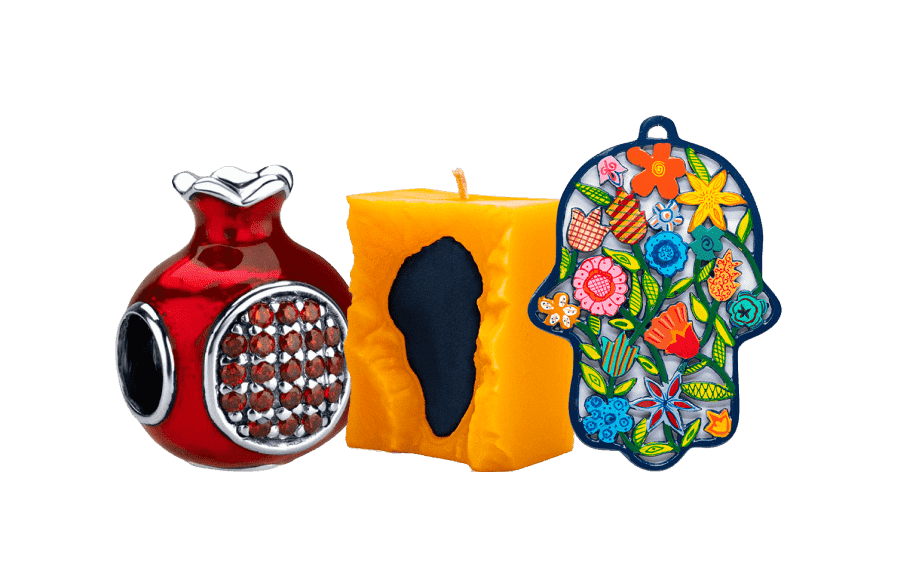From thousands of years ago until today, here are seven facts you need to know about the Holy Temple of Jerusalem which holds such an important place in our hearts!
The Holy Temple of Jerusalem was the center of Jewish life. It was where God's presence permanently rested and where people would come to offer sacrifices, whether to atone for their sins, give thanks to God, or simply honor him. Three times a year, people would take to the roads and head to Jerusalem to make the pilgrimage for the festivals of Pesach, Shavuot, and Sukkot and offer sacrifices at the Temple. It is where the magnificent Yom Kippur Avodah service would take place as the high priest atones for the sins of the nation. Even today, thousands of years after the destruction of the Holy Temple, we still visit and pray at the Western Wall, the last remaining part of the second Temple. In our prayers, we pray for the speedy rebuilding of the Temple in our days!
Seven facts about the Holy Temple you need to know!
1. There were TWO Temples
King Solomon built the first temple in 960 BCE, which stood proudly for 410 years until it was destroyed by the Babylonians under Nebuchadnezzar in 586 BCE, leading to the exile of the Jewish people to Babylon. Around 100 years later, the people returned to Israel, under the leadership of Ezra and Nehemiah, and with the Holy Land now under Persian rule, they were permitted to begin rebuilding the Second Temple in the same spot as the original one. It was completed in 517 BCE and later renovated and expanded by King Herod in 19 CE before the Second Temple was eventually destroyed by the Romans in 70 CE.
2. The Temple was built on land purchased by King David
The site of both the first and second Temples is called Mount Moriah. The Book of Samuel recounts how King David took a census of the people of Israel and that God sent a terrible plague of pestilence across the Holy Land. In order to end the plague, God commanded King David, through the prophet Gad, to build an altar and offer a sacrifice on the threshing floor of Aravnah, the Jebusite. Even after Aravnah offered his land (which included Mount Moriah) and oxen for free, David insisted on purchasing them, which he did with fifty shekels of silver. After offering the sacrifices, the plague ceased. Little did King David know that this investment would also include the land on which the Holy Temple would be built by his son, King Solomon!

3. The site of the Temple is filled with Biblical history
According to the Rambam (Maimonides), many of the recorded events in the first book of the Bible, Genesis, took place at the very same location where the Holy Temple stood! The earth of the area was used by God to create the first man, Adam. And here Adam offered a sacrifice to God, as did his sons Cain and Abel. When the great flood receded, Noah left his Ark and built an altar to God and the episode where our forefather Abraham went to offer up his beloved son Issac to God also took place here.
4. The Temple was integral to carrying out many of the 613 commandments
Did you know that about 180 of the 613 commandments given to the Jewish people are directly related to the Holy Temple? From daily offerings by the priests to personal offerings of individuals, agricultural tithes, activities for the priests and the Levities, and events such as the Yom Kippur Avodah Service or the magnificent water drawing celebrations of Sukkot. And, of course, the annual pilgrimages, which took place three times a year in honor of the three-foot festivals of Pesach, Shavuot, and Sukkot (the name is given because everyone would make the journey up to Jerusalem by foot!). All of these commandments could only be fulfilled while the Temple was functioning.
5. The Temple was HUGE
The Holy Temple, built by King Solomon, was absolutely huge and a magnificent site to behold. At the center of it all was the Holy of Holies (in Hebrew, Kodesh Hakodashim), which the high priest would enter only once a year on Yom Kippur. It was surrounded by several structures and courtyards used for various purposes. For the Temple, King Solomon required vast amounts of building materials, including tons of massive bricks and huge amounts of cedar wood ordered from King Hiram of Tyre. It is recorded in the Book of Kings that over 3000 officials were entrusted to oversee the entire project! The size of the Holy Temple is similar to that of an actual sports stadium, and if you want to get an idea of just how big it was, take a look at the Western Wall, which is just a 'small' part of the Western side of the Temple mount wall!

6. The Temple in our hearts and minds and prayers
While there hasn't been a standing Temple in the Holy Land for thousands of years, it is everpresent among the Jewish people. During Temple times, there would be twice daily sacrificial offerings. Instead, we say Pitum HaKetoret, a prayer that describes in detail the process of these offerings, including what spices were used and the rules to be observed. Whenever we pray, we face in the direction of the Temple in Jerusalem. On Tisha B'Av, we mourn the destruction of the Temple and count how many years it has been that the Jewish people have lived without it. Even in times of joy, we recall and long for the rebuilding of the Temple, such as when the groom recites from Psalms 137, moments before the end of the wedding ceremony:
If I forget you, O Jerusalem, may my right hand forget [its skill]. May my tongue cling to my palate, if I do not remember you, if I do not bring up Jerusalem at the beginning of my joy. (Psalms 137: 5-6)
7: The third temple
Every day, we pray for the rebuilding of the third temple, which will occur with the arrival of the Messiah. According to Maimonides, the Messiah will be the one to build the Temple himself. This time, though, in fulfillment of God's prophecy given to the Prophet Ezekiel, the third Temple will be the final one, remaining forever and never to be destroyed!
And the nations shall know that I am the Lord, Who sanctifies Israel, when My Sanctuary is in their midst forever." (Ezekiel 37:28)
Although we aren't able to build the Temple ourselves, God did tell the Prophet Ezekiel that if they would study in depth the designs of the Holy Temple, then he would consider their study as if they built the Temple with their own hands!
From Temple times until today, the holiness of the Old City, where the Holy Temples once stood in all their glory, remains. The area of the Temple Mount is considered so holy that there have been Rabbinical decrees strictly forbidding Jewish people from ascending there. Of course, others do permit visiting, and many individuals do so.
Thousands of people wind their way through the narrow alleys of Jerusalem's Old City every day, ending up at the Western Wall plaza. Here, they can run their fingers over the smooth surface of the stones, which make up part of the outer retaining wall of the Second Temple. They are touching a stone thousands of years old, one seeped in holiness. Here, they pray, meditate, and make their requests to God, whether it is to find a life partner, for the physical healing of a relative or friend, for success, for the peace of Jerusalem, and of course, for the coming of the Messiah and the speedy rebuilding of the Temple in our days!

With Lev Haolam, you can experience the holiness of the Land of Israel, wherever you are!
We are so excited to work with hundreds of the most talented artisans of the Holy Land! From the Biblical heartlands of Judea and Samaria, the Galilee, and the Golan Heights, they produce thousands of unique and original products that bring the best of Israel directly to YOU!
With these wonderful products, subscribers get to experience their personal tour across the Biblical heartlands of Israel in the comfort of their homes! Along with the accompanying magazine featuring exclusive interviews with the people behind the products, plus updates from Israel on our social channels and exclusive members-only content, you'll get to know Israel like never before! Each product is the pioneer's way of showing subscribers their deepest gratitude and appreciation. This tremendous impact enables them to provide for their families, offer meaningful employment opportunities to those in their communities, and contribute to the region's development.
Bottom line? Every subscriber is playing an active part in revitalizing the Holy Land!









